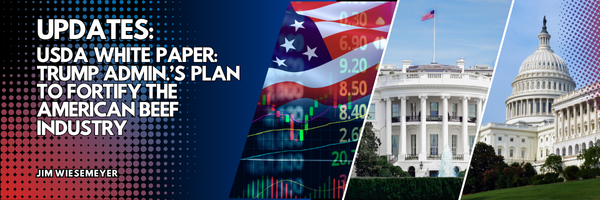
USDA White Paper: The Trump Administration’s Plan to Fortify the American Beef Industry
Sweeping reforms target rancher resilience, market access, and consumer transparency
The USDA Beef Industry Plan White Paper (Link/October 20, 2025) lays out a three-part strategy to rebuild and stabilize the American cattle industry amid historic herd declines. The document underscores that since 2017, the U.S. has lost more than 150,000 ranching operations — a 17% contraction — leaving the national herd at a 75-year low even as domestic beef demand has grown nearly 9%.
I. Protecting and Improving the Business of Ranching
The plan’s first pillar centers on rancher stability, focusing on grazing access, endangered species reform, and expanded risk-management tools.
- USDA–DOI Grazing Action Plan: A new Memorandum of Understanding between the Agriculture and Interior departments (expected November 2025) will reopen millions of acres of vacant grazing allotments, streamline permits, and elevate ranchers’ input in land-use planning. Roughly 10% of federal rangelands—24 million acres—are currently idle. The initiative aims for “no net loss of Animal Unit Months” and seeks to strengthen local economies tied to grazing.
- Endangered Species and Predator Reform: USDA and DOI will develop new standards for compensating ranchers for livestock losses to wolves, bears, and coyotes.
- Enhanced Disaster Relief: Updates to the Livestock Indemnity Program will now cover unborn livestock and raise compensation to 100% of market value for predation losses.
- Affordable Risk Tools for New Ranchers: The Risk Management Agency (RMA) will extend “beginning farmer” status from 5 to 10 years, providing enhanced premium subsidies up to 15 points to new entrants.
- Veteran-Owned Ranching: The AgVets program will prioritize grants for veterans entering cattle production beginning FY 2026.
II. Expanding Processing, Transparency, and Market Access
This second pillar tackles market bottlenecks, labeling accuracy, and small-processor capacity.
- Label Integrity: Starting January 1, 2026, the FSIS will enforce “Product of USA” claims only for meat from animals born, raised, and slaughtered domestically, closing long-criticized loopholes.
- Fair Market Practices: The Agricultural Marketing Service (AMS) will maintain and expand the Cattle Contract Library to improve price discovery and transparency, with DOJ coordination on competition oversight.
- Support for Small Processors:
- FSIS will cut overtime and holiday inspection fees by 75% for very small and 30% for small processors.
- USDA’s Meat and Poultry Processing Expansion Program (MPPEP) will open a fourth grant round of up to $2 million per recipient to boost local processing capacity.
- Up to $25 million guaranteed loans will be available under USDA’s Business and Industry Loan Program, while the SBA will offer low-interest loans to startup meat processors
- Technology Pilots: AMS will test LiDAR and AI tools for feeder cattle grading in 2026, modernizing valuation at auction markets.
- Regulatory Rollbacks: The EPA has withdrawn its 2024 wastewater rule and clarified WOTUS definitions, avoiding an estimated $1.1 billion–$7.8 billion in future compliance costs.
III. Building Demand Alongside Domestic Supply
To avoid the cattle market’s “boom/bust” cycle, USDA and HHS will coordinate to build parallel supply and demand growth.
- Farm-to-School Beef: The Patrick Leahy Farm to School Grant Program will allocate $18 million for local sourcing in school nutrition programs, with grants up to $500,000 to connect ranchers directly with local school districts.
- Science-Based Dietary Guidelines: The upcoming 2025–2030 Dietary Guidelines for Americans—due by year-end—will reaffirm protein, including beef, as a core dietary component for federal nutrition programs, from SNAP to military meal planning.
Summary Assessment
The white paper outlines one of the most comprehensive ranching and beef-sector interventions in decades, linking grazing access, market reform, and nutrition policy under a single framework. It combines deregulation, expanded capital access, labeling enforcement, and domestic demand-building—positioning the cattle industry as both a national security and food-security priority of the Trump Administration.

